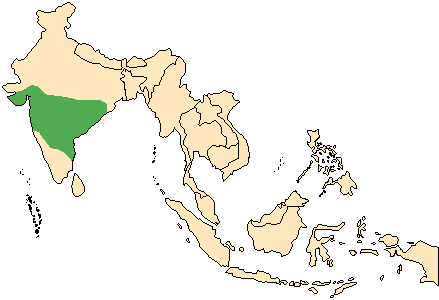![]() Return
to Artiodactyla
Return
to Artiodactyla
Classification
|
 Tetracerus
quadricornis
Tetracerus
quadricornis
Four-horned antelope, Chousingha
![]()
Taxonomy
 |
 |
 |
Click on the pictures above for a larger view of the
photographs
|
||
General Characteristics
Body Length: 90-110 cm / 3-3.6 ft.
Shoulder Height:55-65 cm / 1.8-2.1 ft.
Tail Length: 10-15 cm / 4-6 in.
Weight: 15-25 kg / 33-55 lb.The short, coarse coat is yellow-brown to dark reddish-brown in colour, with the undersides and inside surfaces of the legs being whitish. The nose is generally darker, as is an indistinct stripe which runs down the front of each leg. The legs are slender, and the rump is higher than the rest of the body. The smooth, conical horns, found only in the male of this species, are nearly straight and point upwards. The main pair, found just in front of the ears grow 5-12 cm / 2-4.8 inches long. Usually there is a second, shorter pair of horns on the foremost part of the forehead, reaching a length of only 2-4 cm / 0.8-1.6 inches. These secondary horns may fall off in older animals, or may merely be represented by nodules of black, hairless skin.
Ontogeny and Reproduction
Gestation Period: 7.5-8 months
Young per Birth: 1-3
Life span: Up to 10 years.Mating takes place during the July-September rainy season.
Ecology and Behavior
A shy, wary antelope, the chousingha dashes swiftly for cover at the first sign of danger. The gait of this antelope when walking or running is jerky. The four-horned antelope is rarely found far from a water, and must drink regularly in order to survive. Animals are sedentary, inhabiting more-or-less the same region throughout their lives. Whether territories are formed and defended has yet to be discovered. In the rut, males can be extremely aggressive to members of the same sex. Easily tamed when young, the chousingha is very delicate in captivity. Population densities are usually less then 0.5 animals per square kilometer.Family group: Usually solitary or in pairs.
Diet: Leaves, grasses, shoots, fruit, very dependent on water.
Main Predators: Tiger, leopard, wolf, dhole, small cats.
Distribution
Woodland areas throughout India.

Range Map (Redrawn from Walther, 1990)
Conservation Status
The four-horned antelope is considered vulnerable by the IUCN (1996).
Remarks
Chousingha is a Hindustani name meaning 'four horns'.
Tetra (Greek) four; keras (Greek) the horn of an animal. Quadri- (Latin) prefix meaning four; cornu (Latin) the horn of an animal: therefore Tetracerus quadricornis is a four-horned four-horn - an appropriate name for this unique ungulate.
Literature Cited
Walther, F. R. 1990. Spiral-horned antelopes. In Grzimek's Encyclopedia of Mammals. Edited by S. P. Parker. New York: McGraw-Hill. Volume 5, pp. 344-359.Wilson, D. E., and D. M. Reeder [editors]. 1993. Mammal Species of the World (Second Edition). Washington: Smithsonian Institution Press. Available online at http://nmnhwww.si.edu/msw/
Additional Resources
Boitani, L., and S. Bartoli. 1982. Simon & Schuster's Guide to Mammals. New York: Fireside/Simon & Schuster, Inc. Entry 382.Khan, J. A. 1995. Conservation and management of Gir Lion Sanctuary and National Park, Gujarat, India. Biological Conservation 73(3): 183-188.
Khan, J. A., R. Chellam, W. A. Rodgers, and A. J. T. Johnsingh. 1996. Ungulate densities and biomass in the tropical dry deciduous forests of Gir, Gujarat, India. Journal of Tropical Ecology 12(1): 149-162.
Nowak, R. M. [editor]. 1991. Walker's Mammals of the World (Fifth Edition). Baltimore: The Johns Hopkins University Press.
Prakash, I. 1991. Ecology of artiodactyls in the Thar Desert: their conservation in the Desert Biosphere Reserve. In Mammals in the Palaearctic desert: status and trends in the Sahara-Gobian region. Editted by J. A. McNeely and V. M. Neronov. Moscow: The Russian Committee for the UNESCO Programme on Man and the Biosphere. pp 243-250.
Rice, C. 1989. Four-horned antelope. Gnusletter 8(1): 7.
Singh, H. S. 2001. Antelopes and Gazelles: Distribution and population status in Gujarat, India. Indian Forester 127(10): 1098-1106.
Solounias, N. 1990. A new hypothesis uniting Boselaphus and Tetracerus with the Miocene Boselaphini (Mammalia, Bovidae) based on horn morphology. Annales Musei Goulandris 8: 425-440.
Return to Artiodactyla

![]()
© Brent Huffman, www.ultimateungulate.com |
|
|